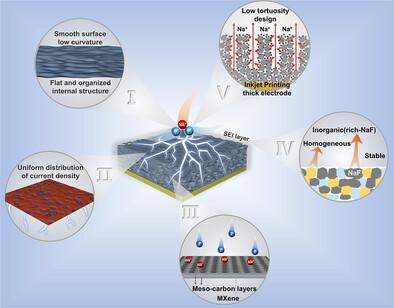MXene-Scaffolded Planner Mesoporous Carbon with Homogeneous Electric Field Enabling Uniform and Robust SEI for Ultra-Stable Sodium Storage
IF 26
1区 材料科学
Q1 CHEMISTRY, PHYSICAL
引用次数: 0
Abstract
For next-generation sodium-ion batteries, nanostructured porous carbons with high surface areas exhibit enhanced rate performance, yet their commercialization is constrained by insufficient cycling stability. Herein, an insight from electrode architecture by using planar 2D MXene@mesoporous carbon (MXene@mesoC) nanosheets are developed to address this challenge. By precisely modulating, the engineered electrode achieves an ultra-smooth surface, which ensures uniform current density and effectively suppresses localized charge accumulation and result a homogeneous electric field. Combined with the mesopore-induced enrichment of PF6− anions in the Inner Helmholtz layer and a significantly reduced decomposition energy barrier catalyzed by MXene, a uniform, robust, and NaF-rich solid electrolyte interphase (SEI) is formed. The resulting anode demonstrates exceptional electrochemical performance, including ultra-stable cycling (98.4% capacity retention after 10 000 cycles at 5.0 A g−1), high average Coulombic efficiency (99.98%), and remarkable low-temperature operation (down to −40 °C). Furthermore, the feasibility of inkjet printing these materials into customizable microstructures highlights their potential for flexible and high-loading electrodes. This electrode architecture strategy bridges nanoscale interfacial regulation with macroscopic electrode design, offering a general approach for advanced sodium-ion storage in the future.

具有均匀电场的mxene -骨架Planner介孔碳,可实现均匀和稳健的SEI用于超稳定钠储存
对于下一代钠离子电池,具有高表面积的纳米结构多孔碳具有增强的倍率性能,但其商业化受到循环稳定性不足的限制。在这里,通过使用平面二维MXene@mesoporous碳(MXene@mesoC)纳米片从电极结构的角度来解决这一挑战。通过精确调制,该电极获得了超光滑的表面,既保证了均匀的电流密度,又有效地抑制了局部电荷的积累,从而形成了均匀的电场。结合介孔诱导的内Helmholtz层中PF6−阴离子的富集和MXene催化的分解能垒的显著降低,形成了均匀、坚固、富naf的固体电解质界面相(SEI)。所制备的阳极具有优异的电化学性能,包括超稳定循环(在5.0 A g−1下循环10000次后容量保持98.4%)、高平均库仑效率(99.98%)和卓越的低温运行(低至- 40°C)。此外,喷墨将这些材料打印成可定制的微结构的可行性突出了它们在柔性和高负载电极方面的潜力。这种电极结构策略将纳米级界面调节与宏观电极设计相结合,为未来先进的钠离子存储提供了一种通用方法。
本文章由计算机程序翻译,如有差异,请以英文原文为准。
求助全文
约1分钟内获得全文
求助全文
来源期刊

Advanced Energy Materials
CHEMISTRY, PHYSICAL-ENERGY & FUELS
CiteScore
41.90
自引率
4.00%
发文量
889
审稿时长
1.4 months
期刊介绍:
Established in 2011, Advanced Energy Materials is an international, interdisciplinary, English-language journal that focuses on materials used in energy harvesting, conversion, and storage. It is regarded as a top-quality journal alongside Advanced Materials, Advanced Functional Materials, and Small.
With a 2022 Impact Factor of 27.8, Advanced Energy Materials is considered a prime source for the best energy-related research. The journal covers a wide range of topics in energy-related research, including organic and inorganic photovoltaics, batteries and supercapacitors, fuel cells, hydrogen generation and storage, thermoelectrics, water splitting and photocatalysis, solar fuels and thermosolar power, magnetocalorics, and piezoelectronics.
The readership of Advanced Energy Materials includes materials scientists, chemists, physicists, and engineers in both academia and industry. The journal is indexed in various databases and collections, such as Advanced Technologies & Aerospace Database, FIZ Karlsruhe, INSPEC (IET), Science Citation Index Expanded, Technology Collection, and Web of Science, among others.
 求助内容:
求助内容: 应助结果提醒方式:
应助结果提醒方式:


